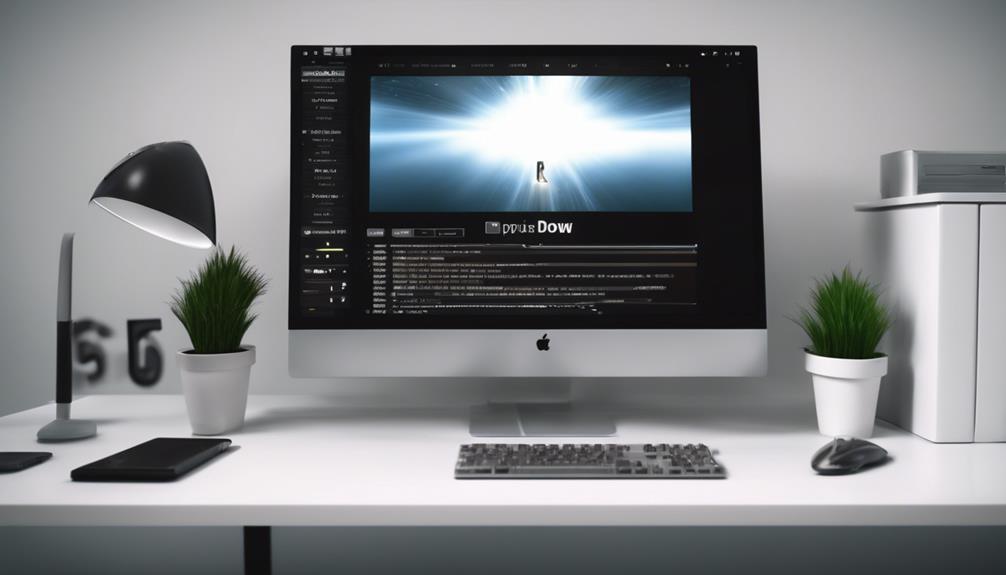Augmented reality (AR) is transforming businesses by enhancing customer engagement and operational efficiency. You can visualize products in 3D, try on items virtually, and improve employee training through immersive experiences. AR also revolutionizes design, streamlining prototyping and collaboration. In healthcare, it aids precise surgeries, while in supply chain management, it boosts logistics and inventory management. The future holds even more potential for AR in various sectors, and there’s much more to explore about its benefits.
Key Takeaways
- Augmented reality enhances product visualization, increasing customer engagement and purchase confidence, leading to reduced return rates in retail.
- Virtual try-on technologies leverage AR and AI, significantly boosting sales conversions and improving customer satisfaction in fashion and beauty industries.
- AR transforms employee training through immersive and interactive experiences, increasing retention and productivity while facilitating remote collaboration.
- In design and prototyping, AR minimizes costs by enabling real-time visualization and collaboration, reducing the need for physical prototypes.
- AR applications in healthcare and supply chain management improve accuracy, efficiency, and employee training, enhancing overall customer experience and satisfaction.
Product Visualization and Customer Engagement

In today’s competitive market, product visualization through augmented reality (AR) is transforming customer engagement. By offering immersive experiences, AR makes products come alive in your space, boosting interaction by 200% compared to traditional methods.
You can explore items from all angles, enhancing your purchase confidence and decreasing the chances of returns. Imagine customizing products in real-time, ensuring they meet your exact preferences. This personalized experience translates to higher conversion rates and increased sales.
Furthermore, AR provides realistic product representations, making it easier for you to visualize true size and design. With cross-device compatibility, these engaging experiences can reach you anywhere, pushing brands to innovate and improve customer satisfaction. Additionally, the rise of sustainable fashion is encouraging brands to adopt AR to showcase eco-friendly materials and production processes.
Embrace AR to elevate your shopping journey!
Virtual Try-On Technologies in Retail
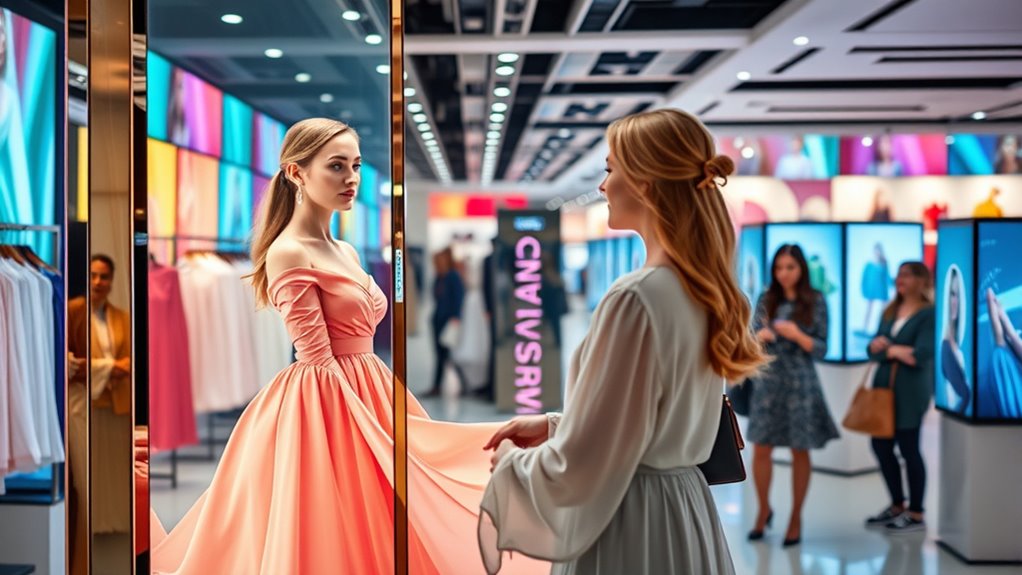
How can virtual try-on technologies revolutionize your shopping experience? With augmented reality (AR) and artificial intelligence (AI), these technologies let you try on clothes, makeup, and accessories virtually, ensuring the right fit before you buy.
Imagine the thrill of seeing how a pair of sunglasses looks on your face without leaving home! Brands like Warby Parker and Sephora are already enhancing customer satisfaction and reducing returns by providing personalized recommendations.
In fact, retailers report a 2.5 times increase in sales conversion thanks to this immersive experience. As more retailers adopt these technologies, you’ll benefit from a more engaging and trustworthy shopping environment, making your decisions easier and more enjoyable.
Virtual try-on is the future of retail!
AR Enhancements in Employee Training
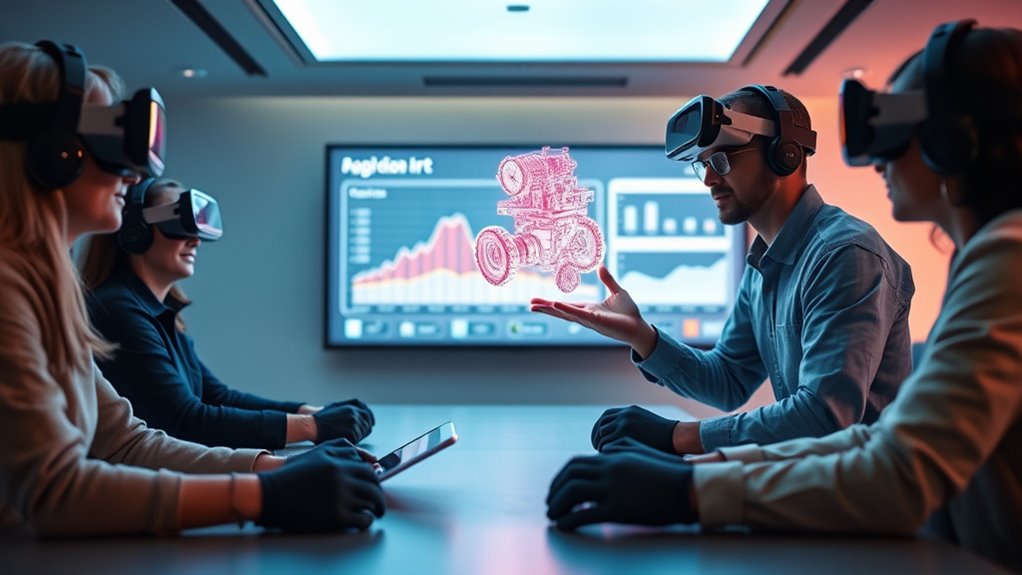
When you think about training your employees, augmented reality (AR) can transform the experience into something interactive and engaging.
With AR, onboarding becomes more efficient, allowing new hires to grasp essential skills through realistic simulations. This approach not only boosts retention but also enhances their ability to apply what they’ve learned in real-world situations.
Interactive Learning Experiences
What if employee training could become a dynamic, engaging experience instead of a tedious chore? With augmented reality (AR), it can! AR combines hands-on experience with immersive visuals, keeping you engaged and motivated.
You’ll find that training time and costs decrease while knowledge retention improves. Imagine practicing real-life scenarios in a safe, controlled environment, allowing you to make mistakes without consequences.
AR provides tailored material and real-time feedback, enhancing your learning experience. Plus, it encourages collaboration among team members, regardless of where they are.
Whether you’re in healthcare or manufacturing, AR’s interactive approach transforms the way you acquire skills, making training not just effective but enjoyable too. Embrace the future of learning with AR!
Onboarding Efficiency Boost
As organizations strive to enhance their onboarding processes, augmented reality (AR) emerges as a powerful tool that transforms traditional practices into engaging, efficient experiences.
You’ll find that AR significantly improves retention rates by making onboarding interactive and enjoyable, much like Walmart’s successful implementation. With immersive experiences, you’ll feel more engaged, leading to higher job satisfaction and productivity.
AR also reduces training time through real-time guidance and interactive simulations, personalizing your learning experience. Additionally, virtual tours help you familiarize yourself with the workplace, alleviating anxiety.
This technology ensures consistent training across all new hires, minimizes errors, and provides immediate feedback, making your onboarding smoother and more effective.
Ultimately, AR cuts costs associated with traditional training methods, enhancing overall efficiency. Furthermore, integrating AR with financial aid sources for onboarding can also support reduced training costs and improve accessibility for all employees.
Skill Development Simulations
Building on the efficiency gains achieved through augmented reality in onboarding, skill development simulations take employee training to the next level.
With AR, you engage in immersive learning experiences that boost knowledge retention. These realistic simulations let you practice skills safely, whether in manufacturing, healthcare, or construction. You’ll receive hands-on training with step-by-step guidance and real-time data, enhancing your technical abilities.
AR also sharpens soft skills like communication and leadership, offering personalized learning paths. Plus, it’s cost-effective, reducing the need for physical facilities.
As AR technology advances, expect even more innovative applications, making your training more effective and engaging. Ultimately, these simulations revolutionize the way you develop critical skills for your career.
Design and Prototyping With Augmented Reality

Augmented Reality (AR) revolutionizes design and prototyping by allowing you to visualize and interact with digital models in real-world settings. This technology cuts costs by minimizing the need for physical prototypes, helping you detect design flaws early.
By fostering real-time collaboration, AR enables you and your team to refine designs together, leading to improved accuracy and creativity. You’ll experience immersive design presentations, enhancing client engagement and understanding.
With cloud-based tools, sharing complex information becomes seamless, while mobile AR enhances realism. Rapid prototyping services can turn your ideas into tangible models within weeks, accelerating your development cycles.
Augmented Reality Applications in Healthcare

The innovative capabilities of augmented reality aren’t just limited to design and prototyping; they’re transforming the healthcare landscape as well.
AR enhances surgical procedures by overlaying critical imaging data onto a patient’s anatomy, improving accuracy and reducing errors. During minimally invasive surgeries, it aids planning and execution, leading to quicker recoveries.
AR revolutionizes surgical procedures by overlaying vital imaging data, enhancing precision and accelerating recovery in minimally invasive surgeries.
In medical education, AR fosters interactive learning, bridging theory and practice for students. You can visualize complex anatomy and even collaborate virtually with experienced surgeons during procedures.
For patient care, AR simplifies complex medical information, helping you understand your conditions better. It also assists nurses with vein detection and supports mental health treatments, showing just how vital AR has become in modern healthcare.
Immersive Experiences in Retail and Customer Experience
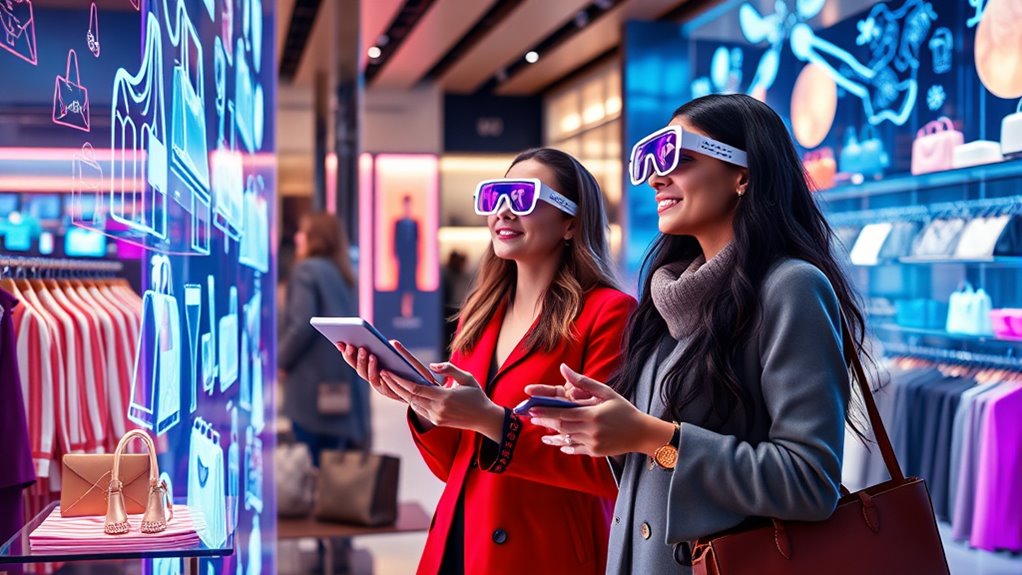
Imagine walking into a store where you can virtually try on clothes and accessories before making a purchase.
With augmented reality, you can enhance product visualization, allowing you to see how items look on you without the hassle of fitting rooms.
This immersive experience not only boosts your confidence in buying decisions but also transforms your overall shopping experience.
Virtual Try-On Solutions
As consumer expectations evolve, virtual try-on solutions are transforming the retail landscape by providing immersive experiences that enhance customer interaction.
The global market for virtual try-ons, valued at $12.5 billion in 2024, is projected to grow to $48.8 billion by 2030, driven by advancements in AR and AI technologies.
Customers today crave personalized shopping experiences, and these solutions deliver just that.
By reducing the need for physical samples, virtual try-ons also minimize returns and their environmental impact.
Brands implementing this technology have seen a 2.5 times increase in sales conversion and a 64% reduction in returns. Additionally, the rise of clean beauty products has led to an increased demand for virtual try-ons in the beauty industry, allowing consumers to experience products without compromising on ingredient transparency.
Enhanced Product Visualization
Augmented Reality (AR) is revolutionizing how you visualize products, creating immersive shopping experiences that enhance your confidence in purchasing decisions.
With AR, you can see how furniture fits in your living room or how makeup looks on your face, providing a clearer understanding of the products. This realistic display reduces uncertainty and encourages informed choices, leading to fewer returns.
Retailers are integrating AR into mobile apps and in-store displays, making shopping more engaging and interactive. As you explore personalized recommendations and access detailed product information, your overall satisfaction increases.
With continuous advancements in AR technology, expect even more captivating experiences that can drive sales and foster customer loyalty. Embrace this innovative approach to elevate your shopping journey!
The Role of AR in Supply Chain Management
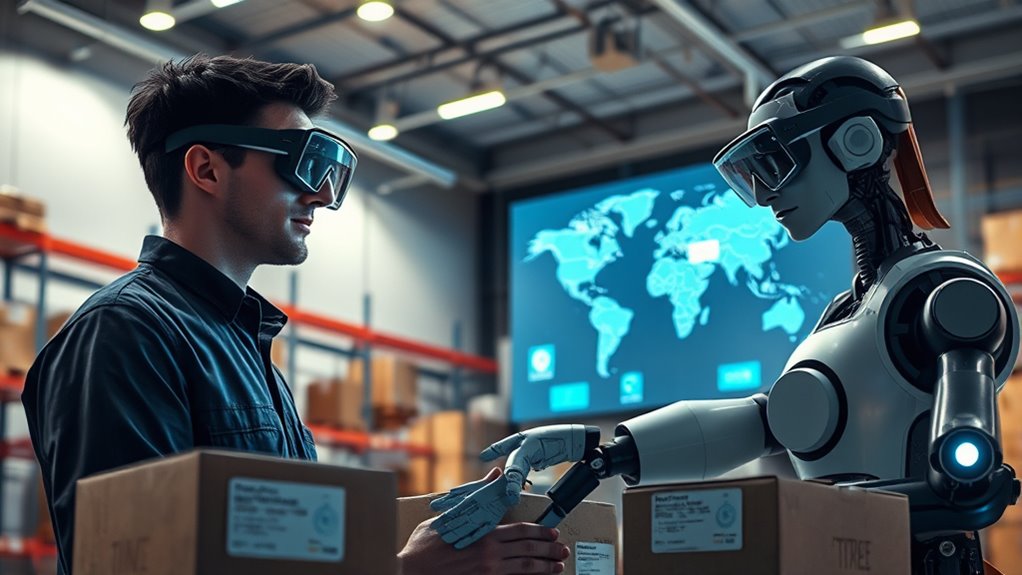
While traditional supply chain management relies heavily on manual processes and static information, the integration of AR technology transforms how businesses operate.
AR enhances warehouse efficiency by providing real-time visual cues, reducing picking errors significantly. You’ll find inventory management streamlined as AR offers instant access to data, minimizing the need for manual checks.
Logistics routes are optimized through AR, lowering transportation and storage costs effectively. Additionally, AR improves employee training by allowing them to practice complex tasks in a virtual environment.
With AR, customer experience is elevated, giving them transparency across the supply chain. Overall, adopting AR leads to increased productivity, reduced errors, and better customer satisfaction, making it a game changer in supply chain management.
Future Business Potential of Digital Twins
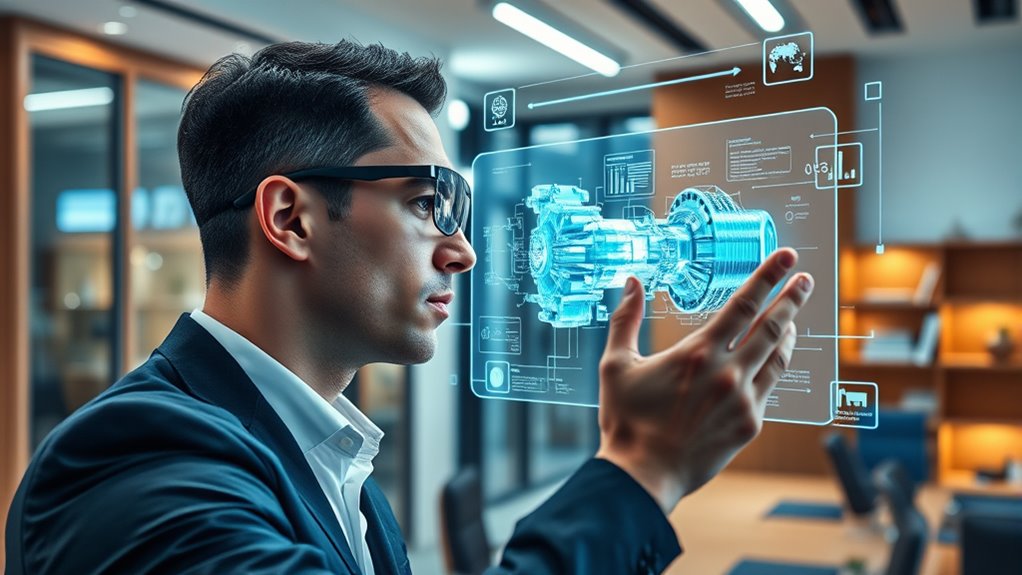
Digital twins are revolutionizing the way businesses operate, offering immense future potential across various industries.
The global digital twin market is projected to soar from $9.5 billion in 2022 to over $72 billion by 2032, reflecting a remarkable CAGR of 22.5%. Major companies like BMW and GE are diving into this technology, particularly for electric and autonomous vehicles.
With digital twins, you can unlock innovative business models like subscription services and proactive maintenance, effectively monetizing your data.
These tools also integrate with IoT and machine learning for real-time insights, enhancing decision-making and driving sustainability by reducing waste and optimizing resources.
Embracing digital twins now positions you to thrive in the evolving landscape of business.
Operational Efficiency Through Augmented Reality
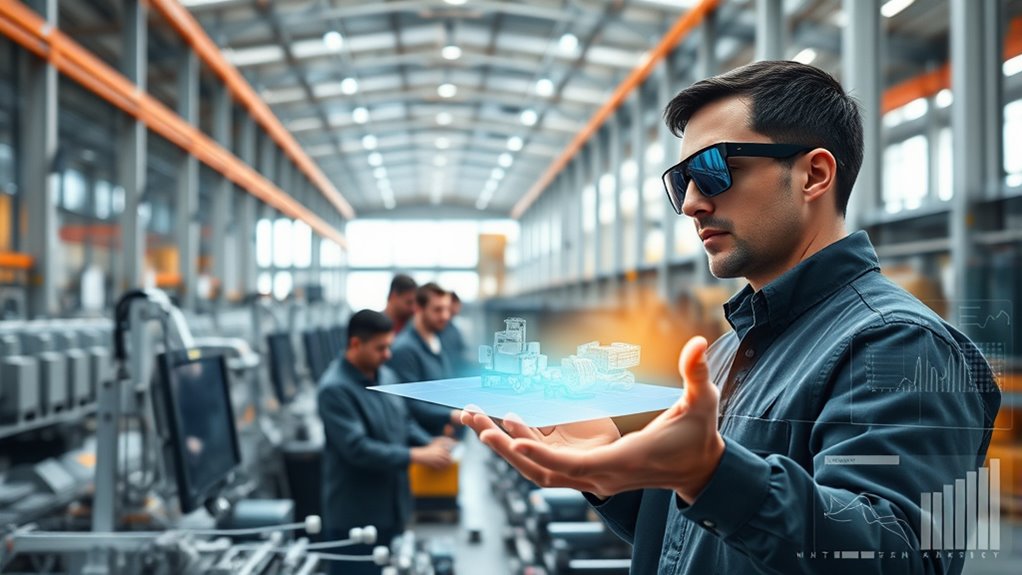
The advancements in digital twins highlight a growing trend in leveraging technology to enhance operational efficiency across various sectors.
With augmented reality (AR), you can optimize assembly processes by guiding workers, reducing errors, and boosting efficiency. For instance, Boeing improved wing assembly time by 35% using AR.
In logistics, smart glasses project item locations, increasing order-picking productivity by up to 25%. AR also facilitates immersive training, enhancing worker skills and productivity significantly.
By offering real-time insights and visual guidance, AR helps you minimize errors and streamline operations.
Whether in manufacturing or warehousing, integrating AR can lead to substantial productivity gains and reduced operational costs, ultimately positioning your business for success in a competitive market.
Frequently Asked Questions
How Does AR Impact Customer Loyalty and Retention?
AR significantly impacts your customer loyalty and retention by creating memorable, interactive experiences.
You engage customers through personalized interactions, making them feel more connected to your brand. When they visualize products in their environment, their confidence in purchases increases, leading to fewer returns.
Plus, by offering unique rewards in loyalty programs, you encourage repeat business.
Ultimately, AR not only enhances satisfaction but also fosters long-term loyalty and advocacy among your customers.
What Industries Can Benefit Most From AR Implementation?
You’ll find that industries like manufacturing, healthcare, and retail can benefit immensely from AR implementation.
In manufacturing, AR boosts productivity and streamlines workflows.
Healthcare professionals enhance surgical outcomes and training with AR.
In retail, AR transforms customer experiences through virtual try-ons and interactive marketing.
Education also thrives as AR creates immersive learning environments.
How Do AR Technologies Integrate With Existing Systems?
AR technologies seamlessly integrate with existing systems by utilizing RESTful APIs for real-time data exchange.
You might need middleware or custom adapters to bridge legacy systems and handle various data formats.
By aligning AR tools with your current workflows, you can ensure user-friendly interfaces that enhance interaction.
Security measures, like data encryption and role-based access, are crucial to protect sensitive information while maintaining compliance and tracking performance through audit trails.
What ARe the Costs Associated With Adopting AR Solutions?
When you’re considering adopting AR solutions, you need to factor in various costs.
Initial investments can range from $10,000 for simple applications to over $200,000 for advanced hardware and software.
Ongoing operational expenses, like salaries and cloud storage, can add $100,000 to $300,000 annually.
Remember, project complexity, hardware choices, and content quality will influence your overall budget.
Planning ahead will help you navigate these expenses effectively.
How Can Businesses Measure AR Campaign Effectiveness?
Imagine a gardener tending to a vibrant garden, measuring growth through blooms and lush leaves.
Similarly, you can gauge your AR campaign’s effectiveness by tracking key metrics like impressions, user engagement, and conversion rates. Count how many users venture into your AR world, the time they spend exploring, and the content they create.
Just like nurturing plants, use these insights to refine your strategies and cultivate a flourishing AR experience that resonates with your audience.
Conclusion
As you navigate the ever-changing landscape of business, augmented reality is a lighthouse guiding you toward innovation. From enhancing customer experiences to streamlining operations, AR is reshaping industries in real-time. The potential is enormous, and by embracing these technologies, you’re not just keeping pace—you’re setting the stage for the future. Dive into AR, and let it illuminate the path to efficiency, engagement, and endless possibilities in your business journey.



